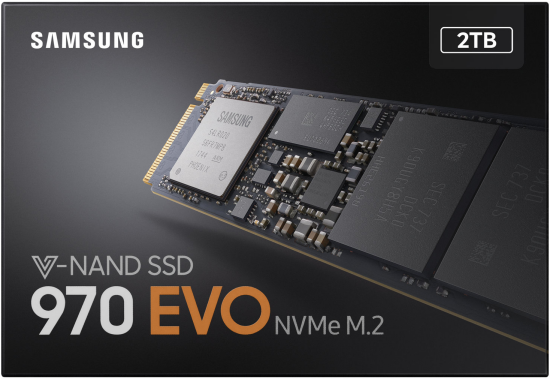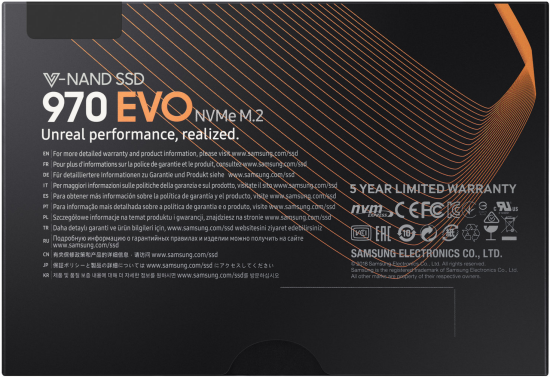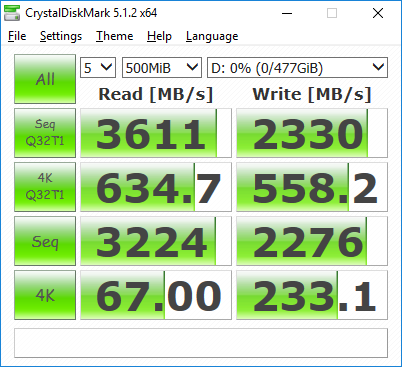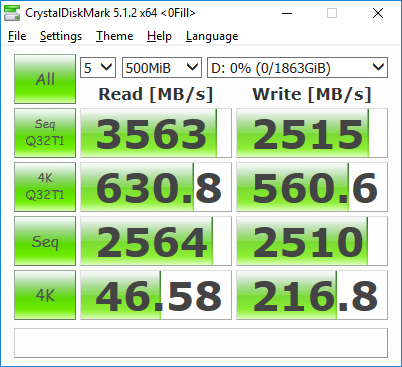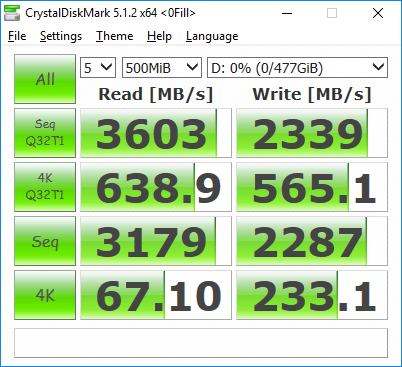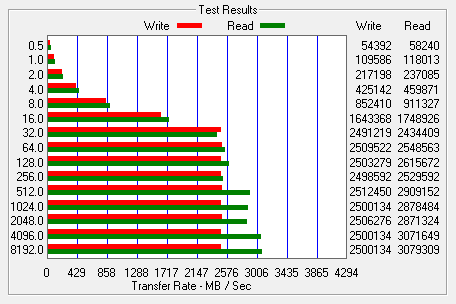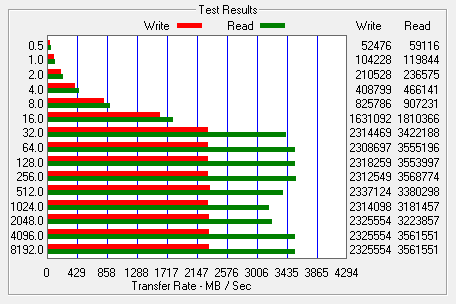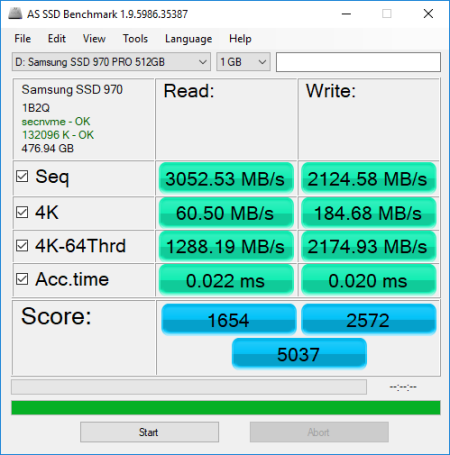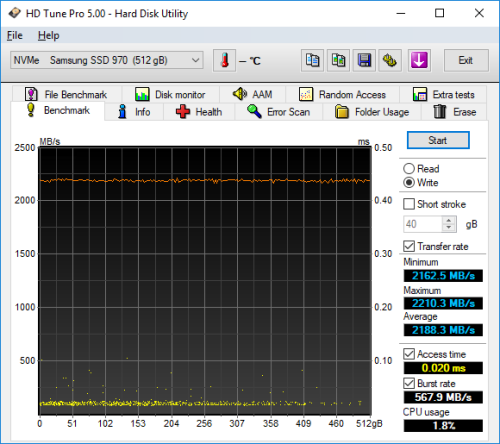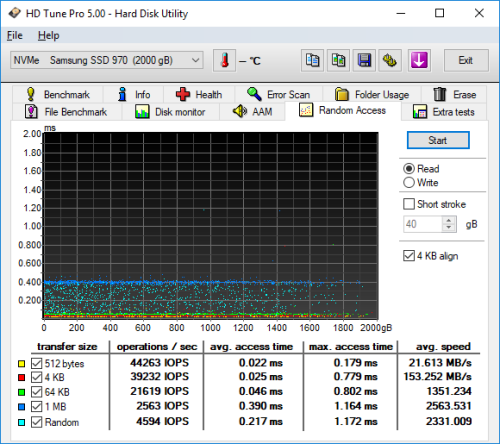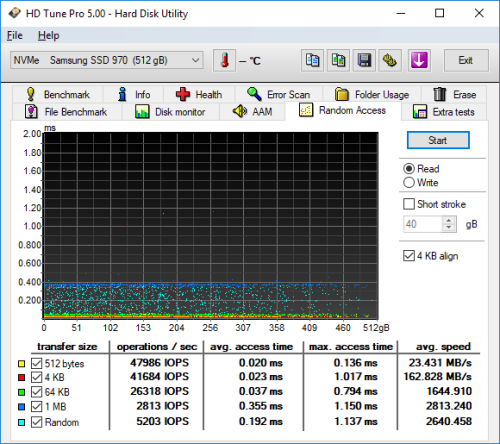
![]()
Model: Samsung 970 EVO 2TB M.2 NVMe PCIe Solid State Drive
Manufacturer: Samsung Electronics
Provided By: Samsung America
Samsung Electronics has been a leader in the electronics industry for more than 30 years. Since the introduction of their first television in 1970, this Korean company has grown to become one of the world's leading electronics manufacturers, offering everything from tiny semiconductors to large home appliances. Samsung is no stranger to the storage industry either. Along with an assortment of DVD and Blu-ray Disc drives, the company offers both hard drive and flash based storage solutions for the portable and desktop computer markets.
Samsung recently introduced its new 970 series SSDs. In addition to their new flagship drive, the 970 PRO, the company released its latest mainstream NVMe SSD, the 970 EVO. Both drives are powered by Samsung's new Phoenix controller and equipped with a PCIe Gen3 x4 NVMe 1.3 interface. The biggest difference between the two is the type of NAND used. Where the 970 PRO features Samsung's 2-bit MLC V-NAND flash, the 970 EVO is available with up to 2TB of their 3-bit MLC (TLC) V-NAND flash. The 970 EVO also utilizes Samsung's Intelligent TurboWrite technology, which uses a large SLC buffer to accelerate sequential write speeds.
The 970 EVO is available in 250GB, 500GB, 1TB and 2TB capacities. For this review, Samsung sent us the 2TB version of the drive, which is capable of delivering up to 3,500 MB/s sequential read and 2,500 MB/s sequential write speeds as well as up to 500,000 random read and 480,000 random write IOPS.

Needless to say, this is only a taste of what the 970 EVO has to offer. To give you an idea of what to expect, we'll take a closer look at Samsung's new NVMe SSD and then see how well it performs. Does the 970 EVO have what it takes? Can it deliver the performance and features that we've come to expect from Samsung? Keep reading as we find out.
The 970 EVO comes in a small black box. While there aren't a lot of details on the front, the back of the box advertises some of the drive's key features including its V-NAND technology, NVMe interface and 5 year warranty. Inside, you'll find the SSD as well as a small installation guide and warranty statement.

Physical Features:
The 970 EVO uses the 2280 form factor for M.2 (NGFF) SSDs. It measures 80.15 x 22.15 x 2.38 mm and tips the scales at a mere 8.0g. The drive also has an "M key" edge connector which provides PCIe SSDs with up to 4x lanes of bandwidth.

Like the PM981 and 970 PRO, the 970 EVO uses Samsung's new Phoenix controller. The controller's technical specs are confidential so we don't know a lot about it yet. However, Samsung did let us know that in addition to it supporting the latest NVMe 1.3 specification, the Phoenix controller has a new nickel coating that dissipates heat. Like the older Polaris controller, one core is also dedicated to processing data sent between the host system and the controller. However, with the Phoenix, it runs at a higher clock speed for faster data transfer rates.


For the 2TB version of the 970 EVO, Samsung has used their own 64-layer, 3-bit MLC V-NAND flash chips. Looking at the pictures above, you can see that there are two 1TB NAND flash packages on the top of the PCB. The drive also has a single 2GB LPDDR4 DRAM memory chip that is used for caching.
The test system used in this review is equipped with an Intel Core i7-6700K CPU, GIGABYTE GA-Z170X-UD3 motherboard, 32GB (16GB x 2) of Crucial Ballistix Sport LT DDR4 memory, Samsung 960 PRO 512GB SSD and a GIGABYTE GeForce GTX 1060 WINDFORCE OC 6G graphics card. For the operating system, I installed a fresh copy of Windows 10 Enterprise.
To test the performance of Samsung's 970 EVO SSD, I ran a series of benchmarks using CrystalDiskMark, HD Tach RW, ATTO Disk Benchmark, AS SSD, HD Tune Pro, Anvil's Storage Utilities, Iometer and PCMark 8. For comparison, I've also included test results from the Samsung 970 PRO, Plextor M9Pe, Plextor M8Se, Patriot Hellfire, ADATA XPG SX8000, Samsung 960 PRO, Toshiba OCZ RD400, Samsung 950 PRO, Crucial MX500, Plextor M8V, Crucial BX300, ADATA Ultimate SU900, Plextor S3C, Toshiba OCZ VX500, ADATA Ultimate SU800, Plextor S2C, Crucial MX300, Plextor M7V, PNY CS1311, OCZ Trion 150, PNY CS2211, Plextor M6V, Crucial BX200, OCZ Trion 100, Kingston HyperX Savage, Crucial MX200, OCZ Vector 180 and Samsung SSD 850 EVO.

As I mentioned earlier, the 970 EVO uses Samsung's new Phoenix controller chip. Looking at the screenshot above, you can see that it performs equally well with both incompressible (0%) and compressible (100%) data.
CrystalDiskMark 5.1.2:
First, I ran a few quick tests using CrystalDiskMark. This benchmark tool measures the performance of a storage device by testing its sequential read and write speeds as well as its random read and write speeds using blocks 512K and 4K in size.
According to Samsung, the 2TB 970 PRO is capable of reading at 3,500 MB/s and writing at 2,500 MB/s. Looking at the screenshot above, you can see that the drive had no problems reaching these speeds in CrystalDiskMark's sequential read and write tests.
The 970 EVO performed equally well when using highly compressible 0x00 (0 Fill) data. This time around, the drive was able to read at 3,563 MB/s and write at 2,515 MB/s.
HD Tach RW 3.0.4.0:
Next, I used HD Tach to test the 970 EVO's read, write and burst speeds as well as its seek times and CPU usage.
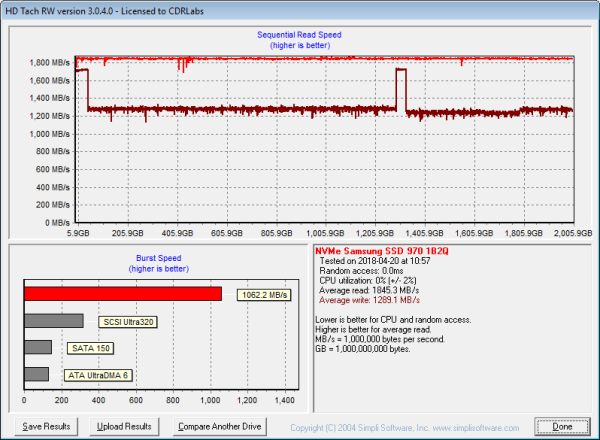
Looking at the screenshot above, you can see that the 970 EVO had average read and write speeds of 1,845.3 MB/s and 1,289.1 MB/s respectively, as well as a burst speed of 1062.2 MB/s. The screenshot also shows the transition from TurboWrite to what Samsung calls "After TurboWrite" speeds. The 970 EVO starts writing at about 1,700 MB/s and then drops to about 1,250 MB/s when the consecutive write operation exceeds the size of the SLC buffer.
ATTO Disk Benchmark 2.46:
I also used ATTO Disk Benchmark to test the 970 EVO's sequential read and write speeds. The tests are run using blocks ranging in size from 0.5KB to 8192KB and the total length set to 256MB.
When tested with ATTO, the 970 EVO's read speeds topped out at about 3,079 MB/s and its write speeds at 2,506 MB/s.
AS SSD:
AS SSD is a benchmark designed specifically for solid state drives. The application contains five synthetic tests which are used to determine the sequential and random read and write performance of a drive.
AS SSD also includes a copy benchmark. This test copies an ISO (two large files), program (many small files) and game (small and large files), returning the speed and duration of each.
HD Tune Pro 5.00:
Next, I ran a series of tests using HD Tune Pro. This hard disk utility measures a drive's performance by testing its sequential read and write speeds as well as its access time, burst rate and CPU usage. For this review, I'm also going to use it to benchmark the 970 EVO's random read and write speeds, random access times and the number of operations per second.
The 970 EVO performed relatively well when benchmarked with HD Tune. The drive had average read and write speeds of 2,458.3 MB/s and 1318.6 MB/s, respectively, and a burst rate of 209.0 MB/s when reading.
The 970 EVO didn't disappoint when doing random reads and writes. When reading 4KB blocks, the drive reached 39,232 IOPS and had an average speed of 153.252 MB/s. It was even faster when writing, reaching 44,204 IOPS with an average speed of 172.675 MB/s.
Anvil's Storage Utilities:
Anvil's Storage Utilities is another benchmark designed with SSDs in mind. The standard storage benchmark measures a drive's performance by testing its transfer speeds, access times and IOPS.
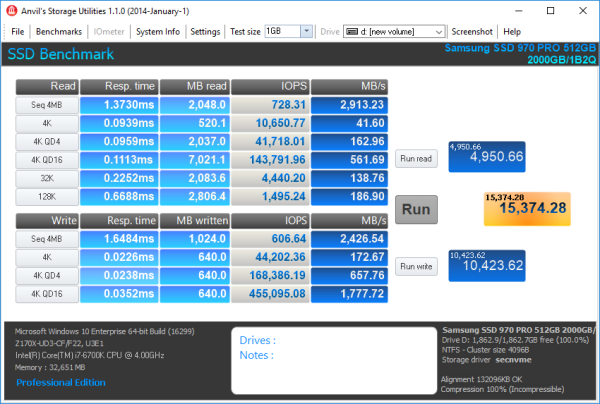
Iometer:
Lastly, I ran a series of tests using Iometer. This tool can be configured to benchmark a number of things. In this case, I used it to measure the 970 EVO's read and write speeds and the number of operations per second. The tests were run using random bytes and a queue depth of 3.

The 970 EVO's performance was very similar to what we saw in our other tests. The drive was able to read at 3159.27 MB/s and write at 2392.66 MB/s.

The 970 EVO also performed very well when doing random reads and writes. In our tests, the drive was able to read at 235.29.22 MB/s and write at a whopping 902.08 MB/s.

According to Samsung, the 2TB 970 EVO is capable of 500,000 IOPS when reading and 480,000 IOPS when writing 4K blocks. In our tests, the drive reached 60,235 random read IOPS and 230,934 random write IOPS. As with most drives, the 970 EVO performed better at higher queue depths. With four threads and the queue depth set to 32, it reached 365,971 random read IOPS and 442,705 random write IOPS.
PCMark 8 - Storage Test:
PCMark 8 is a complete benchmark for Windows. It includes five benchmark tests, each designed around a specific scenario. The storage benchmark measures drive performance using real-world traces recorded from Adobe Creative Suite, Microsoft Office and a selection of popular games.

PCMark 8 also includes a consistency test which measures the performance consistency and degradation tendency of a storage system. The test reports the performance level at the start, the degraded steady-state and the recovered state as well as the number of iterations required to reach the degraded state and the recovered state. For this test, we are focusing on the Adobe Photoshop (Heavy) trace and will look at both the bandwidth and latency of the drive

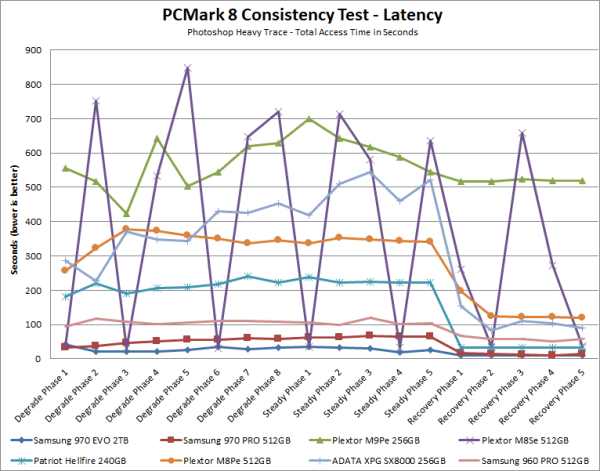
Like the 970 PRO, the 970 EVO did quite well throughout PCMark's consistency test. While the average bandwidth dropped below 1,000 MB/s during the degradation and steady state phases, it was still considerably faster than the other PCIe SSDs that we've tested. More importantly, the 970 EVO had no problems bouncing back during the recovery phase.
TRIM Performance:
While SSDs offer many benefits, there are some downsides to using flash memory. One of the biggest issues people run into is performance degradation. Over time, an SSD will run out of fresh blocks and will have to write over data the file system has marked as deleted. This procedure is very complicated and can slow an SSD's write speeds considerably.
To fix this problem, most manufacturers have added TRIM support to their SSDs. The TRIM command allows an operating system, such as Windows 10, to tell an SSD which data blocks are no longer in use. Using this information, the drive pro-actively erases these blocks and adds them to the free block pool.
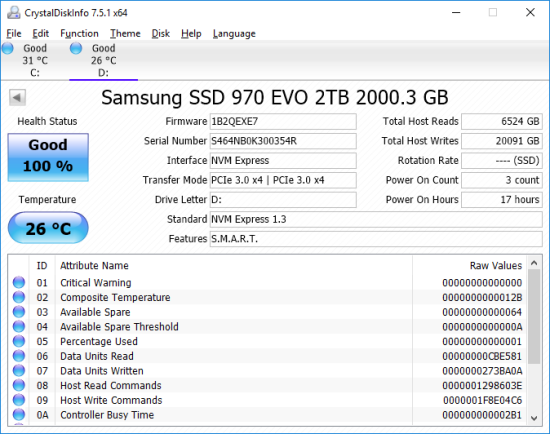
To test the 970 EVO's TRIM and garbage collection functions, I first put the drive in a "dirty" state. I used Iometer to fill the entire drive and then ran a random write test for 30 minutes. This had little impact on the 970 EVO's read speed. However, its average writing speed dropped to 444.6 MB/s.

Samsung 970 EVO - Dirty
To see how well the 970 EVO could recover, I let the computer sit for about 45 minutes and then reran the test. The drive wasn't able to reach the factory fresh performance shown in our earlier tests. However, its average read speed jumped up to 1144.5 MB/s.

Samsung 970 EVO - After TRIM
Lastly, I used Parted Magic to perform a secure erase on the 970 EVO. With the drive wiped clean, it had average read and write speeds of 1846.0 MB/s and 1506.6 MB/s, respectively.

Samsung 970 EVO - Secure Erased
Dynamic Thermal Guard:
While Samsung's NVMe SSDs offer impressive performance, they also generate a good amount of heat. To keep them from overheating, Samsung has implemented what they call Dynamic Thermal Guard (DTG). This technology monitors the temperature of a drive and will reduce its performance once it reaches a certain point.
This thermal throttling was a big issue when we reviewed the 950 PRO. Even with basic benchmarks like CrystalDiskMark or ATTO, the drive's temperature would reach a point where DTG would kick in and reduce its performance. It got to a point where I needed to position an 8cm fan directly over the 950 PRO so that I could complete the tests.
The 970 EVO is also equipped with Dynamic Thermal Guard. However, Samsung has tried to delay the inevitable drop in performance by dissipating heat more efficiently. Like the 960 EVO, the 970 EVO has a copper heat spreader built into the label on the back of the drive. Samsung has also gone one step further by using a new nickel coating on the Phoenix controller that is helps dissipate heat faster.

Right off the bat, I noticed that the 970 EVO ran hotter than the 960 PRO in my test system. At idle, the 970 EVO's temperature hovered around 33 ºC. When pushed hard, these temps climbed up to 79 ºC before DTG was triggered, reducing performance. It took a lot to do this though. Looking at the screenshot below, you can see that more than 800GB worth of data was written before there was a major drop in performance. Even then, the 970 EVO still continued to write at more than 900 MB/s.

If you're going to push the 970 EVO hard and don't want DTG to activate, you may want to consider adding a cooling fan or attach a heatsink to the drive. With an 8cm fan blowing over the drive, I saw a dramatic drop in temps. At idle, the drive's temperature dropped down to 24 ºC and rose to 45 ºC under heavy workloads.

Final Thoughts:
With the 970 EVO, Samsung has proven once again that good things do come in small packages. Designed for tech savvy consumers, gamers and professionals, this compact, M.2 form factor SSD is powered by the same Phoenix controller found in the 970 PRO and is available with up to 2TB of Samsung's latest 3-bit MLC V-NAND flash. Combine this with the company's Intelligent TurboWrite technology and a PCIe Gen3 x4 NVMe 1.3 interface and you have one of the fastest mainstream NVMe SSDs on the market today. The 2TB version of the 970 EVO rocketed through our sequential transfer rate tests, reading at speeds as high as 3,564 MB/s and writing at more than 2,500 MB/s. The drive also did very well in our random write tests, producing more than 230,000 IOPS at low queue depths.
Impressive performance isn't the only thing the 970 EVO has to offer. Along with support for Samsung's Intelligent TurboWrite technology, the drive features AES 256-bit full disk encryption and is compliant with both the TCG Opal 2.0 and IEEE 1667 specifications. The 970 EVO also supports the Device Sleep (DEVSLP) standard which extends the battery life of a device by reducing the drive's power consumption when it's not in use. To top it all off, the 970 EVO is covered by a 5 year warranty with an endurance rating of up to 1,200 terabytes written (TBW) for the 2TB model.
The 970 EVO is available now in 250GB, 500GB, 1TB and 2TB capacities. Prices on Amazon.com currently range from $109.99 up to $799.99 for the 2TB version reviewed here.

Highs:
- PCIe 3.0 x4 interface with NVMe protocol
- Equipped with 3-bit MLC V-NAND technology
- Available in 250GB, 500GB, 1TB and 2TB capacities
- Excellent sequential and random read and write speeds
- Performs equally well with compressible and incompressible data
- Small M.2 2280 form factor
- Large DRAM cache
- Supports TRIM and garbage collection
- AES 256-bit full disk encryption
- TCG Opal 2.0 and IEEE 1667 compliant
- Works with Samsung's Magician software
- 5 year warranty
Lows:
- Can get hot under heavy workloads
